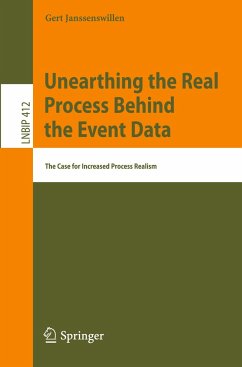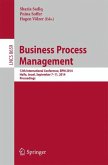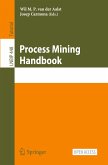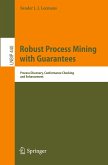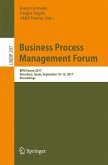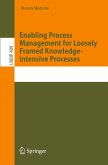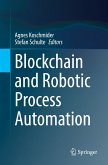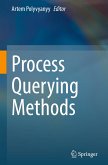Gert Janssenswillen
Unearthing the Real Process Behind the Event Data
The Case for Increased Process Realism
Gert Janssenswillen
Unearthing the Real Process Behind the Event Data
The Case for Increased Process Realism
- Broschiertes Buch
- Merkliste
- Auf die Merkliste
- Bewerten Bewerten
- Teilen
- Produkt teilen
- Produkterinnerung
- Produkterinnerung
This book is a revised version of the PhD dissertation written by the author at Hasselt University in Belgium. This dissertation introduces the concept of process realism. Process realism is approached from two perspectives in this dissertation. First, quality dimensions and measures for process discovery are analyzed on a large scale and compared with each other on the basis of empirical experiments. It is shown that there are important differences between the different quality measures in terms of feasibility, validity and sensitivity. Moreover, the role and meaning of the generalization…mehr
Andere Kunden interessierten sich auch für
![Business Process Management Business Process Management]() Business Process Management38,99 €
Business Process Management38,99 €![Process Mining Handbook Process Mining Handbook]() Process Mining Handbook42,79 €
Process Mining Handbook42,79 €![Robust Process Mining with Guarantees Robust Process Mining with Guarantees]() Sander J. J. LeemansRobust Process Mining with Guarantees79,17 €
Sander J. J. LeemansRobust Process Mining with Guarantees79,17 €![Business Process Management Forum Business Process Management Forum]() Business Process Management Forum38,99 €
Business Process Management Forum38,99 €![Enabling Process Management for Loosely Framed Knowledge-intensive Processes Enabling Process Management for Loosely Framed Knowledge-intensive Processes]() Steven MertensEnabling Process Management for Loosely Framed Knowledge-intensive Processes39,99 €
Steven MertensEnabling Process Management for Loosely Framed Knowledge-intensive Processes39,99 €![Blockchain and Robotic Process Automation Blockchain and Robotic Process Automation]() Blockchain and Robotic Process Automation47,99 €
Blockchain and Robotic Process Automation47,99 €![Process Querying Methods Process Querying Methods]() Process Querying Methods85,99 €
Process Querying Methods85,99 €-
-
-
This book is a revised version of the PhD dissertation written by the author at Hasselt University in Belgium.
This dissertation introduces the concept of process realism. Process realism is approached from two perspectives in this dissertation. First, quality dimensions and measures for process discovery are analyzed on a large scale and compared with each other on the basis of empirical experiments. It is shown that there are important differences between the different quality measures in terms of feasibility, validity and sensitivity. Moreover, the role and meaning of the generalization dimension is unclear. Second, process realism is also tackled from a data point of view. By developing a transparent and extensible tool-set, a framework is offered to analyze process data from different perspectives. From both perspectives, recommendations are made for future research, and a call is made to give the process realism mindset a central place within process mining analyses.
In 2020, the PhD dissertation won the "BPM Dissertation Award", granted to outstanding PhD theses in the field of Business Process Management.
This dissertation introduces the concept of process realism. Process realism is approached from two perspectives in this dissertation. First, quality dimensions and measures for process discovery are analyzed on a large scale and compared with each other on the basis of empirical experiments. It is shown that there are important differences between the different quality measures in terms of feasibility, validity and sensitivity. Moreover, the role and meaning of the generalization dimension is unclear. Second, process realism is also tackled from a data point of view. By developing a transparent and extensible tool-set, a framework is offered to analyze process data from different perspectives. From both perspectives, recommendations are made for future research, and a call is made to give the process realism mindset a central place within process mining analyses.
In 2020, the PhD dissertation won the "BPM Dissertation Award", granted to outstanding PhD theses in the field of Business Process Management.
Produktdetails
- Produktdetails
- Lecture Notes in Business Information Processing 412
- Verlag: Springer / Springer International Publishing / Springer, Berlin
- Artikelnr. des Verlages: 978-3-030-70732-3
- 1st ed. 2021
- Seitenzahl: 300
- Erscheinungstermin: 8. April 2021
- Englisch
- Abmessung: 235mm x 155mm x 17mm
- Gewicht: 458g
- ISBN-13: 9783030707323
- ISBN-10: 3030707326
- Artikelnr.: 61091831
- Herstellerkennzeichnung Die Herstellerinformationen sind derzeit nicht verfügbar.
- Lecture Notes in Business Information Processing 412
- Verlag: Springer / Springer International Publishing / Springer, Berlin
- Artikelnr. des Verlages: 978-3-030-70732-3
- 1st ed. 2021
- Seitenzahl: 300
- Erscheinungstermin: 8. April 2021
- Englisch
- Abmessung: 235mm x 155mm x 17mm
- Gewicht: 458g
- ISBN-13: 9783030707323
- ISBN-10: 3030707326
- Artikelnr.: 61091831
- Herstellerkennzeichnung Die Herstellerinformationen sind derzeit nicht verfügbar.
Part I Introduction.- 1 Process Realism.- 1.1 Introduction to Process Mining.- 1.1.1 Business Process Management.- 1.1.2 The emergence of process mining.- 1.1.3 Perspectives.- 1.1.4 Tools.- 1.1.5 Towards Evidence-based Business Process Management.- 1.2 The case for Process Realism.- 1.2.1 Motivation.- 1.2.2 Research objective.- 1.3 Methodology and Outline.- 1.3.1 Process Model Quality.- 1.3.2 Process Analytics.- Part II Process Model Quality.- 2 Introduction to Conformance Checking.- 2.1 Introduction to Process Mining.- 2.1.1 Preliminaries.- 2.1.2 Process.- 2.1.3 Event log.- 2.1.4 Model.- 2.2 Quality Dimensions.- 2.2.1 Fitness.- 2.2.2 Precision.- 2.2.3 Generalization.- 2.2.4 Simplicity.- 2.3 Quality Measures.- 2.3.1 Fitness.- 2.3.2 Precision.- 2.3.3 Generalization.- 2.4 Conclusion.- 2.5 Further Reading.- 3 Calculating the Number of Distinct Paths in a Block-Structured Model.- 3.1 Introduction.- 3.2 Formal Algorithm.- 3.2.1 Assumptions and used notations.- 3.2.2 Generic approach.- 3.2.3Block Functions.- 3.2.4 Limitations.- 3.3 Implementation.- 3.3.1 Preliminaries.- 3.3.2 Algorithm.- 3.3.3 Extended Block Functions.- 3.3.4 Silent transitions and duplicate tasks.- 3.4 Performance.- 3.5 Conclusion and future work.- 3.6 Further Reading.- 4 Comparative Study of Quality Measures.- 4.1 Introduction.- 4.2 Problem Statement.- 4.3 Methodology.- 4.3.1 Generate systems.- 4.3.2 Calculate the number of paths.- 4.3.3 Simulate logs.- 4.3.4 Discover models.- 4.3.5 Measure quality.- 4.3.6 Statistical Analysis.- 4.4 Results.- 4.4.1 Feasibility.-4.4.2 Validity.- 4.4.3 Sensitivity.- 4.5 Discussion.- 4.6 Conclusion.- 4.7 Further Reading.- 5 Reassessing the Quality Framework.- 5.1 Introduction.- 5.2 Exploratory versus confirmatory process discovery.- 5.2.1 Problem statement.- 5.3 Methodology.- 5.3.1 Generate systems.- 5.3.2 Simulate logs.- 5.3.3 Discover models.- 5.3.4 Measure log-quality.- 5.3.5 Measure system-quality.- 5.3.6 Statistical analysis.- 5.4 Results.- 5.4.1 Log versus system-perspective.- 5.4.2 Generalization.- 5.5 Discussion.- 5.6 Conclusion.- 5.7 Further Reading.- 6 Towards Mature Conformance Checking.- 6.1 Synthesis.- 6.1.1 Fitness.- 6.1.2 Precision.- 6.1.3 Generalization.- 6.2 Future research.- 6.2.1 System-fitness and system-precision.- 6.2.2 Improving the Experimental Setup.- Part III Process Analytics.- 7 Reproducible Process Analytics.- 7.1 Introduction.- 7.2 Problem Statement.- 7.3 Requirements Definition.- 7.3.1 Functionality requirements.- 7.3.2 Design Requirements.- 7.4 Design and Development of Artefact.- 7.4.1 Core packages.- 7.4.2 Supplementary packages.- 7.5 Demonstration of Artefact.- 7.5.1 Event data extraction.- 7.5.2 Data Processing.- 7.5.3 Mining and Analysis.- 7.6 Discussion.- 7.7 Conclusion.- 7.8 Further Reading.- 8 Student Trajectories in Higher Education.- 8.1 Learning analytics and process mining.- 8.2 Data Understanding.- 8.3 Followed versus prescribed trajectories.- 8.3.1 Root causes.- 8.3.2 Impact.- 8.4 Failure Patterns.- 8.4.1 Bags.- 8.4.2 High-level analysis.- 8.4.3 Low-level analysis.- 8.5 Understanding Trajectory Decisions.- 8.6 Discussion.- 8.7 Conclusion.- 8.8 Further Reading.- 9 Process-Oriented Analytics in Railway Systems.- 9.1 Introduction.- 9.2 Problem statement and related work.- 9.3 Methodology.- 9.3.1 Rerouting severity.- 9.3.2 Rerouting diversity.- 9.3.3 Discovering patterns.- 9.4 Results.- 9.4.1 Rerouting severity.- 9.4.2 Rerouting diversity.- 5 Discussion.- 9.6 Conclusions.- 9.7 Further Reading.- Part IV Conclusions.- 10 Conclusions and Recommendations for Future Research.- 10.1 Process Model Quality.- 10.1.1 Lessons Learned.- 10.1.2 Recommendations for Future Research.- 10.2 Process Analytics.- 10.2.1 Lessons Learned.- 10.2.2 Recommendations for Future Research.- Afterword.- A Additional Figures and Tables Chapter 4.- B Function Index bupaR packages.- B.1 bupaR.- B.2 edeaR.- B.3 evendataR.- B.4 xesreadR.- B.5 processmapR.- B.6 processmonitR.- B.7 petrinetR.- B.8 ptR.- B.9 discoveR.- CScripts Chapter 8.- D Scripts Chapter 9.- References.
Part I Introduction.- 1 Process Realism.- 1.1 Introduction to Process Mining.- 1.1.1 Business Process Management.- 1.1.2 The emergence of process mining.- 1.1.3 Perspectives.- 1.1.4 Tools.- 1.1.5 Towards Evidence-based Business Process Management.- 1.2 The case for Process Realism.- 1.2.1 Motivation.- 1.2.2 Research objective.- 1.3 Methodology and Outline.- 1.3.1 Process Model Quality.- 1.3.2 Process Analytics.- Part II Process Model Quality.- 2 Introduction to Conformance Checking.- 2.1 Introduction to Process Mining.- 2.1.1 Preliminaries.- 2.1.2 Process.- 2.1.3 Event log.- 2.1.4 Model.- 2.2 Quality Dimensions.- 2.2.1 Fitness.- 2.2.2 Precision.- 2.2.3 Generalization.- 2.2.4 Simplicity.- 2.3 Quality Measures.- 2.3.1 Fitness.- 2.3.2 Precision.- 2.3.3 Generalization.- 2.4 Conclusion.- 2.5 Further Reading.- 3 Calculating the Number of Distinct Paths in a Block-Structured Model.- 3.1 Introduction.- 3.2 Formal Algorithm.- 3.2.1 Assumptions and used notations.- 3.2.2 Generic approach.- 3.2.3Block Functions.- 3.2.4 Limitations.- 3.3 Implementation.- 3.3.1 Preliminaries.- 3.3.2 Algorithm.- 3.3.3 Extended Block Functions.- 3.3.4 Silent transitions and duplicate tasks.- 3.4 Performance.- 3.5 Conclusion and future work.- 3.6 Further Reading.- 4 Comparative Study of Quality Measures.- 4.1 Introduction.- 4.2 Problem Statement.- 4.3 Methodology.- 4.3.1 Generate systems.- 4.3.2 Calculate the number of paths.- 4.3.3 Simulate logs.- 4.3.4 Discover models.- 4.3.5 Measure quality.- 4.3.6 Statistical Analysis.- 4.4 Results.- 4.4.1 Feasibility.-4.4.2 Validity.- 4.4.3 Sensitivity.- 4.5 Discussion.- 4.6 Conclusion.- 4.7 Further Reading.- 5 Reassessing the Quality Framework.- 5.1 Introduction.- 5.2 Exploratory versus confirmatory process discovery.- 5.2.1 Problem statement.- 5.3 Methodology.- 5.3.1 Generate systems.- 5.3.2 Simulate logs.- 5.3.3 Discover models.- 5.3.4 Measure log-quality.- 5.3.5 Measure system-quality.- 5.3.6 Statistical analysis.- 5.4 Results.- 5.4.1 Log versus system-perspective.- 5.4.2 Generalization.- 5.5 Discussion.- 5.6 Conclusion.- 5.7 Further Reading.- 6 Towards Mature Conformance Checking.- 6.1 Synthesis.- 6.1.1 Fitness.- 6.1.2 Precision.- 6.1.3 Generalization.- 6.2 Future research.- 6.2.1 System-fitness and system-precision.- 6.2.2 Improving the Experimental Setup.- Part III Process Analytics.- 7 Reproducible Process Analytics.- 7.1 Introduction.- 7.2 Problem Statement.- 7.3 Requirements Definition.- 7.3.1 Functionality requirements.- 7.3.2 Design Requirements.- 7.4 Design and Development of Artefact.- 7.4.1 Core packages.- 7.4.2 Supplementary packages.- 7.5 Demonstration of Artefact.- 7.5.1 Event data extraction.- 7.5.2 Data Processing.- 7.5.3 Mining and Analysis.- 7.6 Discussion.- 7.7 Conclusion.- 7.8 Further Reading.- 8 Student Trajectories in Higher Education.- 8.1 Learning analytics and process mining.- 8.2 Data Understanding.- 8.3 Followed versus prescribed trajectories.- 8.3.1 Root causes.- 8.3.2 Impact.- 8.4 Failure Patterns.- 8.4.1 Bags.- 8.4.2 High-level analysis.- 8.4.3 Low-level analysis.- 8.5 Understanding Trajectory Decisions.- 8.6 Discussion.- 8.7 Conclusion.- 8.8 Further Reading.- 9 Process-Oriented Analytics in Railway Systems.- 9.1 Introduction.- 9.2 Problem statement and related work.- 9.3 Methodology.- 9.3.1 Rerouting severity.- 9.3.2 Rerouting diversity.- 9.3.3 Discovering patterns.- 9.4 Results.- 9.4.1 Rerouting severity.- 9.4.2 Rerouting diversity.- 5 Discussion.- 9.6 Conclusions.- 9.7 Further Reading.- Part IV Conclusions.- 10 Conclusions and Recommendations for Future Research.- 10.1 Process Model Quality.- 10.1.1 Lessons Learned.- 10.1.2 Recommendations for Future Research.- 10.2 Process Analytics.- 10.2.1 Lessons Learned.- 10.2.2 Recommendations for Future Research.- Afterword.- A Additional Figures and Tables Chapter 4.- B Function Index bupaR packages.- B.1 bupaR.- B.2 edeaR.- B.3 evendataR.- B.4 xesreadR.- B.5 processmapR.- B.6 processmonitR.- B.7 petrinetR.- B.8 ptR.- B.9 discoveR.- CScripts Chapter 8.- D Scripts Chapter 9.- References.

